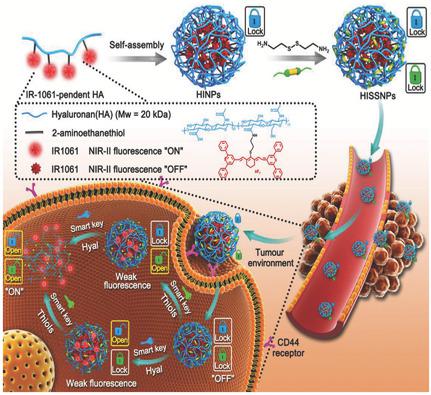当前位置:
X-MOL 学术
›
Adv. Mater.
›
论文详情
Our official English website, www.x-mol.net, welcomes your feedback! (Note: you will need to create a separate account there.)
“Dual Lock‐and‐Key”‐Controlled Nanoprobes for Ultrahigh Specific Fluorescence Imaging in the Second Near‐Infrared Window
Advanced Materials ( IF 29.4 ) Pub Date : 2018-06-19 , DOI: 10.1002/adma.201801140 Yufu Tang 1 , Yuanyuan Li 1 , Xiaoming Hu 1 , Hui Zhao 1 , Yu Ji 1 , Liang Chen 1 , Wenbo Hu 1 , Wansu Zhang 1 , Xiang Li 1 , Xiaomei Lu 2 , Wei Huang 1, 2, 3 , Quli Fan 1
Advanced Materials ( IF 29.4 ) Pub Date : 2018-06-19 , DOI: 10.1002/adma.201801140 Yufu Tang 1 , Yuanyuan Li 1 , Xiaoming Hu 1 , Hui Zhao 1 , Yu Ji 1 , Liang Chen 1 , Wenbo Hu 1 , Wansu Zhang 1 , Xiang Li 1 , Xiaomei Lu 2 , Wei Huang 1, 2, 3 , Quli Fan 1
Affiliation

|
Fluorescence imaging in the second near‐infrared window (NIR‐II) is a new technique that permits visualization of deep anatomical features with unprecedented spatial resolution. Although attractive, effectively suppressing the interference signal of the background is still an enormous challenge for obtaining target‐specific NIR‐II imaging in the complex and dynamic physiological environment. Herein, dual‐pathological‐parameter cooperatively activatable NIR‐II fluorescence nanoprobes (HISSNPs) are developed whereby hyaluronic acid chains and disulfide bonds act as the “double locks” to lock the fluorescence‐quenched aggregation state of the NIR‐II fluorescence dyes for performing ultrahigh specific imaging of tumors in vivo. The fluorescence can be lit up only when the “double locks” are opened by reacting with the “dual smart keys” (overexpressed hyaluronidase and thiols in tumor) simultaneously. In vivo NIR‐II imaging shows that they reduce nonspecific activitation and achieve ultralow background fluorescence, which is 10.6‐fold lower than single‐parameter activatable probes (HINPs) in the liver at 15 h postinjection. Consequently, these “dual lock‐and‐key”‐controlled HISSNPs exhibit fivefold higher tumor‐to‐normal tissue ratio than “single lock‐and‐key”‐controlled HINPs at 24 h postinjection, attractively realizing ultrahigh specificity of tumor imaging. This is thought to be the first attempt at implementing ultralow background interference with the participation of multiple pathological parameters in NIR‐II fluorescence imaging.
中文翻译:

在第二个近红外窗口中用于超高比荧光成像的“双重锁定和键控”纳米探针
在第二个近红外窗口(NIR-II)中进行荧光成像是一项新技术,可以可视化以前所未有的空间分辨率显示深层解剖特征。尽管具有吸引力,但有效地抑制背景干扰信号仍然是在复杂而动态的生理环境中获得目标特定的NIR-II成像的巨大挑战。在本文中,开发了双病理参数可协同激活的NIR-II荧光纳米探针(HISSNP),其中透明质酸链和二硫键充当“双锁”,以锁定NIR-II荧光染料的荧光猝灭聚集态,从而实现体内肿瘤的超高特异性成像。仅当通过与“双重智能钥匙”(肿瘤中过度表达的透明质酸酶和硫醇)反应打开“双锁”时,荧光才能点亮。体内NIR-II成像显示,它们可减少非特异性激活并实现超低背景荧光,这比注射后15 h肝脏中的单参数可激活探针(HINP)低10.6倍。因此,在注射后24 h,这些“双重锁定和钥匙”控制的HISSNP的肿瘤与正常组织之比比“单一锁定和钥匙”控制的HINP高五倍,从而吸引人地实现了肿瘤成像的超高特异性。这被认为是在NIR-II荧光成像中涉及多个病理参数的情况下实现超低背景干扰的首次尝试。
更新日期:2018-06-19
中文翻译:

在第二个近红外窗口中用于超高比荧光成像的“双重锁定和键控”纳米探针
在第二个近红外窗口(NIR-II)中进行荧光成像是一项新技术,可以可视化以前所未有的空间分辨率显示深层解剖特征。尽管具有吸引力,但有效地抑制背景干扰信号仍然是在复杂而动态的生理环境中获得目标特定的NIR-II成像的巨大挑战。在本文中,开发了双病理参数可协同激活的NIR-II荧光纳米探针(HISSNP),其中透明质酸链和二硫键充当“双锁”,以锁定NIR-II荧光染料的荧光猝灭聚集态,从而实现体内肿瘤的超高特异性成像。仅当通过与“双重智能钥匙”(肿瘤中过度表达的透明质酸酶和硫醇)反应打开“双锁”时,荧光才能点亮。体内NIR-II成像显示,它们可减少非特异性激活并实现超低背景荧光,这比注射后15 h肝脏中的单参数可激活探针(HINP)低10.6倍。因此,在注射后24 h,这些“双重锁定和钥匙”控制的HISSNP的肿瘤与正常组织之比比“单一锁定和钥匙”控制的HINP高五倍,从而吸引人地实现了肿瘤成像的超高特异性。这被认为是在NIR-II荧光成像中涉及多个病理参数的情况下实现超低背景干扰的首次尝试。



























 京公网安备 11010802027423号
京公网安备 11010802027423号